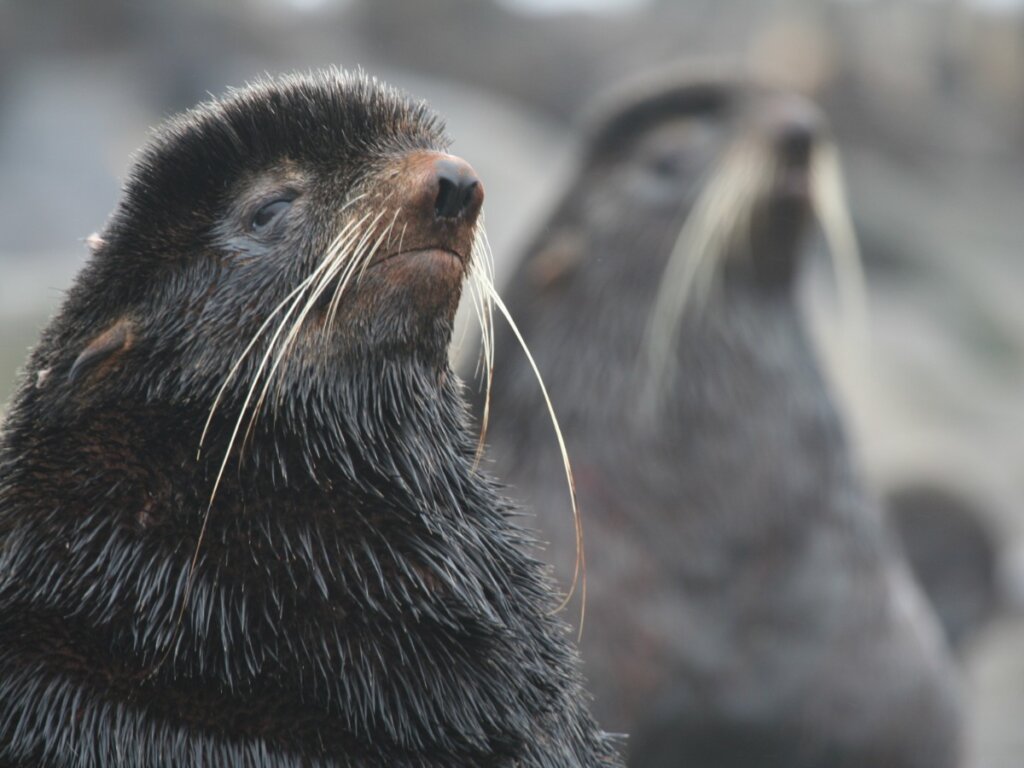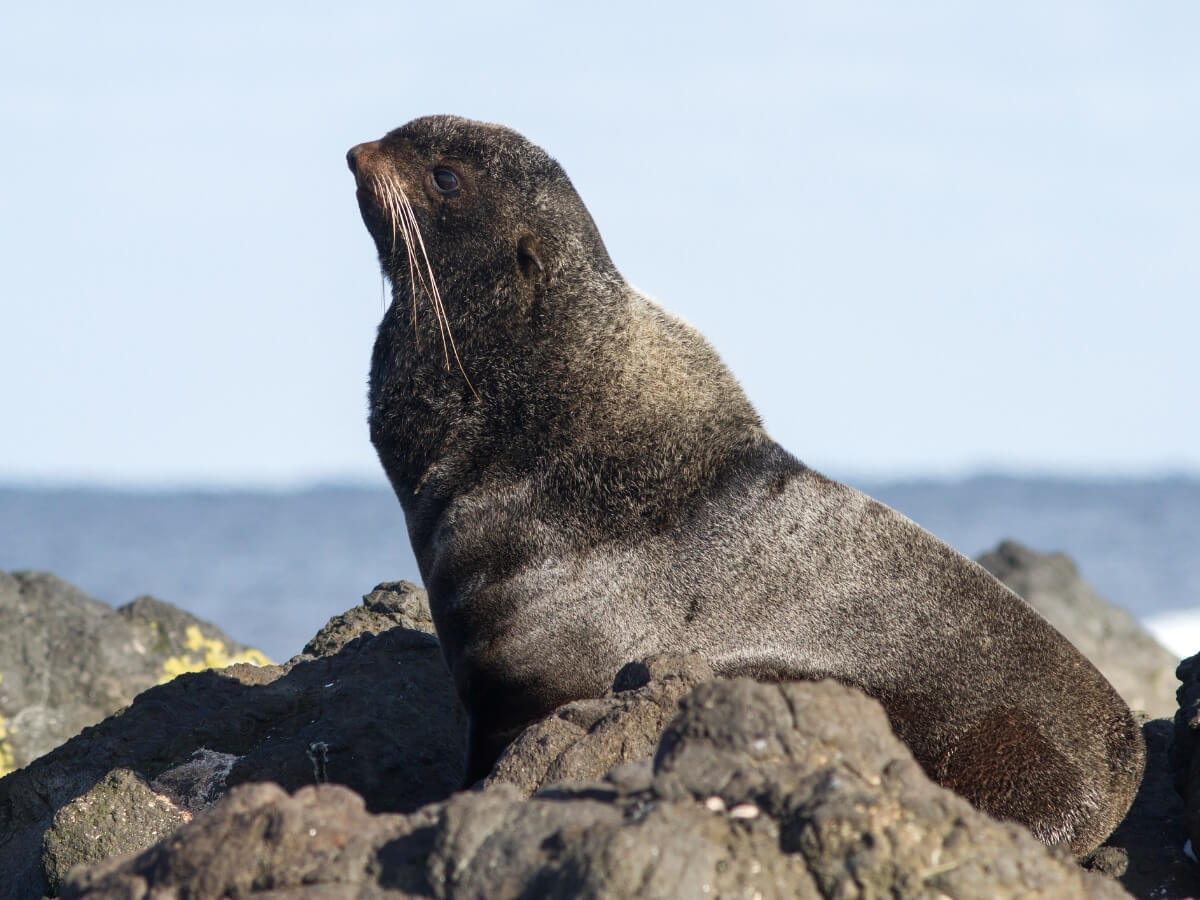Northern Fur Seal: Habitat and Characteristics

The northern fur seal is known for its beautiful fur and spends most of its time in the water, swimming aimlessly. Among its most obvious characteristics is its peculiar sexual dimorphism, which makes the difference between males and females rather noticeable.
The ears on its head give it away as a false seal, a group of mammals also known as “fur seals”. Northern fur seals (Callorhinus ursinus) belong to the pinniped group and are close relatives of sea lions. Read on to learn more about this furry animal.
Northern fur seal habitat
Fur seals have a wide distribution, spanning the northern Pacific Ocean, the Bering Sea, and the Sea of Okhotsk, all the way to Japan. Most of these organisms stay far from the coasts, between 80 and 160 kilometers (50 to 100 miles) away. Furthermore, although they can reach the Arctic Circle, they are more common in intermediate waters.
Their habits consist of swimming in the open sea throughout the day, while returning to land only for the mating season. Thus, fur seals only spend an approximate interval of 35 to 45 days on land per year.
They’re solitary animals that spend most of their lives drifting, occasionally diving to hunt.

Physical characteristics
This species is quite heavy, with males reaching lengths of 213 centimeters (7 feet) and weights of 275 kilograms (606 pounds). However, females are smaller and weigh around 50 kilograms (100 pounds). This indicates an excessive difference between genders, or, in other words, the presence of unusual sexual dimorphism.
Its body is oval and elongated, with a short but flexible head, and a large amount of fur. Its skin coloration has dark shades of brown, black, and gray. On the other hand, its limbs consist of elongated fins, which are entirely hairless. The latter is an important taxonomic feature, as it serves to identify the species.
The ears of these mammals are conspicuous, naked, and elongated with dark colors, although not very noticeable. These mammals also exhibit a form of vibrissae “hairs”, which originate near the mouth and extend beyond their ears. In fact, these “whiskers” go through an aging process, causing them to lose their color as the individual matures, similar to the gray hairs of humans.
Northern fur seal feeding
These marine mammals are carnivores, so their diet consists of different fish and cephalopods. To facilitate their hunting, they primarily attack anchovy, herring, capelin, squid and other species that move in groups. This doesn’t limit them, as they will feed on whatever they can in order to survive. For this reason, they are considered to be opportunistic animals.
Northern fur seals tend to feed at night, because at this time several fish swim up to the surface. However, they’ll use any opportunity they have to obtain their prey, regardless of the time of day or environmental conditions.
Reproduction of Northern fur seals
These seals are polygamous mammals that tend to form “harems”, in which the male dominates a territory to mate with several females. This event takes place every year on the coasts of certain islands, where the males arrive first and start disputes to defend their domains. Although it sounds aggressive, the fights are only threats that rarely end in physical injury.
In general, most of the specimens return to their native islands to reproduce, causing regions with high populations. In this sense, the areas that stand out are the Pribilof Islands, the San Miguel Islands, California, Russia, and the Bering Sea.
In fact, according to an article in the scientific journal Animal Behaviour, as these mammals mature they become more motorically effective and are able to return to the island where they were born.
Males have no control over the number of mates that enter their harem, as it’s the females that choose which one to belong to.
In this sense, the females select the territory depending on the size of the group, which is why they end up crowding around the coasts. The success or failure of a male rests in the “hands” of the females.
Gestation and birth of the young
Reproduction takes place annually and the new mothers arrive to give birth on the coasts between the months of May and June. Once the pups are born, these females stay in the harems to copulate with the males and become pregnant again. In this way, the new mothers take advantage of their time on land before heading out to sea again.
The mother is the only one with minimal parental behavior, as she provides food for the pup during the first days of life. In mid-July, the female will leave her offspring to go in search of food, which will take about 4 months. Thus, in November she returns to feed her young for the last time and migrates south for the winter, abandoning her offspring in the process.
Pausing pregnancy
Females have the ability to delay implantation, an event known as embryonic diapause. This means that the process is somewhere in between being pregnant and not being pregnant, as if the embryo were “frozen”. The usual gestation takes about 8 months, but the 4 months that an embryonic diapause lasts can extend it up to a year.
Independence of the offspring
Being abandoned by their parents doesn’t pose a great risk to the offspring, as they are quite precocious, independent animals. This means that, after being abandoned by their mothers (in mid-November), they survive and learn to hunt by their own means.
This situation causes the mortality rate of the young to be very high and most of them will die before reaching 5 years of age, despite being a long-lived species that can reach 26 years of age. This can cause problems for the species, as they don’t reach sexual maturity until late in life (between 8 and 10 years of age).
Conservation status
According to the International Union for Conservation of Nature, this species is classified as vulnerable. In the past, this animal’s skin was considered a great source of income. In fact, at one time, between 40,000 and 126,000 Northern fur seals were hunted each year.
There are some programs that have been able to control the hunting of this mammal, but they haven’t been completely effective. For this reason, although its population seems stable, it’s feared that there may be other undetected problems that could negatively affect it. At this point, due to the lack of information, management plans can only be strengthened and the creation of protection zones encouraged.

The two main factors that threaten the Northern fur seal are humans and their own biology. For this reason, the best option is to seek a balance that will allow the growth of the species’ populations and, at the same time, promote its coexistence with human beings.
All cited sources were thoroughly reviewed by our team to ensure their quality, reliability, currency, and validity. The bibliography of this article was considered reliable and of academic or scientific accuracy.
- Scheffer, V. B., & York, A. E. (1997). Timing of implantation in the northern fur seal, Callorhinus ursinus. Journal of Mammalogy, 78(2), 675-683.
- Temte, J. L. (1985). Photoperiod and delayed implantation in the northern fur seal (Callorhinus ursinus). Reproduction, 73(1), 127-131.
- Daniel Jr, J. C. (1981). Delayed implantation in the northern fur seal (Callorhinus ursinus) and other pinnipeds. Journal of reproduction and fertility. Supplement, 29, 35-50.
- Bartholomew, G. A., & Hoel, P. G. (1953). Reproductive behavior of the Alaska fur seal, Callorhinus ursinus. Journal of Mammalogy, 34(4), 417-436.
- Baker, J. D., Antonelis, G. A., Fowler, C. W., & YORK, A. E. (1995). Natal site fidelity in northern fur seals, Callorhinus ursinus. Animal Behaviour, 50(1), 237-247.
- Kenyon, K. W., & Wilke, F. (1953). Migration of the northern fur seal, Callorhinus ursinus. Journal of Mammalogy, 34(1), 86-98.
- Towell, R. G., Ream, R. R., & York, A. E. (2006). Decline in northern fur seal (Callorhinus ursinus) pup production on the Pribilof Islands. Marine Mammal Science, 22(2), 486-491.
- Gelatt, T., Ream, R. & Johnson, D. 2015. Callorhinus ursinus. The IUCN Red List of Threatened Species 2015: e.T3590A45224953. https://dx.doi.org/10.2305/IUCN.UK.2015-4.RLTS.T3590A45224953.en. Downloaded on 31 July 2021.
